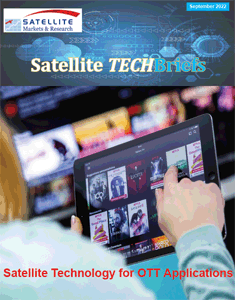Rami Moussawi, Senior Product Manager ST Engineering iDirect
Herndon, Va., August 18, 2022--To shed light on the role that satellite technology plays in the broadcast markets, Satellite Markets and Research Editor-in-Chief Virgil Labrador spoke with Rami Moussawi, Senior Product Manager, ST Engineering iDirect
 |
| Rami Moussawi |
What are the key trends that you see in the satellite broadcast market?
The standout trend that we currently see is the rise in popularity of streaming services. The likes of Netflix, Hulu, Disney Plus, Amazon Prime and many more are revolutionizing how we watch TV and consume content. OTT services are replacing traditional viewing behavior, allowing viewers to stream content on any device, at anytime, anywhere. The global appetite for direct to device streaming shows no sign of being satisfied anytime soon. More choice, new content types and more personalization put service providers and distributors in a prime position to capitalize on technological advancements made in the satellite communications sector.
Satellite can provide unrivalled cost economics for end users and reach territories where internet access is patchy. And new developments and research mean that the introduction of IP over satellite allows the delivery of pure data transmission, with video as a prime example. Developments in IP networking, Over-the-Top (OTT) services and satellite capabilities are converging into exciting ecosystems like SKYflow – ensuring that the new age of content delivery is fully taken advantage of.
The other significant trend we see is an increased use of the cloud in the film and broadcast world. A significant breakthrough in these industries is the use of remote production – or Remote Integration Model (REMI). This allows live content to be captured from a remote location and managed from a master control room. As long as there is reliable access to the cloud computing, a production crew can work and collaborate effectively with the rest of their team anywhere in the world.
Cloud computing is an incredibly powerful tool in any producer’s portfolio. For example, it can allow remote sound or video editors directly to pick the files from the cloud, allowing for simple and easy access no matter where the location is. From feature film productions to news crews and sports broadcasting, cloud access is the powerful enabler of productivity. This leads to an increased demand for satellite connectivity as part of a blended all-IP solution, especially in remote areas. Satellite’s reach and reliability mean that it’s a perfect fit for connectivity to the cloud.
Another main trend is that broadcasters are embracing more IP technology. We’ve previously seen a rise in popularity of the use of competing technologies in the form of cellular bonding. However, in countries that have patchy access, the cellular network cannot be relied upon and therefore satellite is still the best means to secure and safe access to bandwidth. Satellite remains a very important access technology for broadcasters where cellular coverage is not always available, especially in remote areas. This type of technology is particularly important for satellite newsgathering, for example.
Can you give us a brief overview of your key product offerings for the broadcast market?
ST Engineering iDirect offers a wide portfolio of products for the broadcast market for distribution and contribution as well as turnkey broadcasting solutions.
As a market share leader of 80% in DTH, our large installed base proves that end-users and professional users benefit from our efficient technologies and mature product range. Just like other businesses, broadcasters are also faced with increasing pressure on operating margins, while also having to retain high expectations in service availability and reliability (Service Level Agreement compliance). Our technology allows broadcasters to evolve with the changing technologies, offering solutions that are flexible and scalable, and at the same time guarantee bandwidth efficient, OPEX friendly transmissions.
Today’s news crews require access to many applications, including Voice-over-IP (VoIP), video clip transfer, web and archive browsing, email and social media. All these applications require a reliable bi-directional IP “multiservice” communication link of a sizeable bandwidth, which allows news crews to operate as if they were in the studio. As the event may not be planned ahead of time, it is often unclear which type of IP connectivity will be available and reliable during the entire duration of the coverage.
By offering broadcast turnkey solutions we are able to design, develop and deliver state-of-the-art hybrid satellite /terrestrial network infrastructures which support the contribution and distribution of news material in multiple live and file formats. These media networks connect broadcasters and media service providers all together. This enables services to be operated in a much smarter way, leading to benefits like reduced OPEX and CAPEX but most importantly, it provides a timely response to the changing and growing needs of customers.
We also constantly strive to stay ahead of the curve. We are one of the pioneers of the SKYflow ecosystem which is a set to be a true game changer for OTT service providers. It’s set to benefit a range of industries, not only the broadcast world.
Can you tell us more about the SKYflow ecosystem?
Yes. The demand for access to first-class content anytime and anywhere is being tackled by a consortium of companies that have created an ecosystem that allows the first end-to-end, multi-vendor demo of the B2C use of Native IP - demonstrating origination, transport, reception and consumption of live OTT video over satellite.
To enable service providers and telcos to deliver content to satisfy the many use cases that require satellite delivery of OTT services – be it media and broadcast, or the plethora of other use cases beyond them including helping educational institutions, healthcare, and mobility markets – we, along with our partners, have created a breakthrough multicast ABR ecosystem.
At a time when the broadcast sector is seeing unprecedented change, with digital firmly on the scene, the classic challenge of latency issues around internet media has been a barrier to satellite formatting. Now, the arrival of new technology allows the industry to dramatically reinvent OTT outreach and completely change the status quo.
Combining the power and bandwidth of satellite with huge viewer convenience and flexibility, the ability to send OTT video content over satellite represents a completely new - and highly significant - industry landmark. It’s also one that is fully DVB-NIP compliant, meeting the new standard being developed by DVB. The delivery of native IP over satellite creates a range of possibilities for mobile and multi-room viewing, education video distribution and network cost savings.
The ecosystem has redefined satellite’s role in OTT delivery and will enable service providers and telcos to deliver content to any device in any location, satisfying the many use cases that require satellite delivery of OTT services.
Can you highlight some of the ecosystem’s benefits?
From the satellite perspective, existing video service providers can enjoy an open door to OTT business models. Meanwhile, newer entrants can see value in satellite to offload congested backbones and expand the footprint - and satellite transmission is fully compatible with the standardization currently underway across diverse telecommunications networks.
Mobile network operators will be able to complement their 5G services with satellite connectivity to offload terrestrial networks at a large scale. They will be able to take advantage of satellite’s inherent multi-casting/ broadcast functionality for all new use cases, such as connected cars, while preserving a high-value wireless spectrum for latency-sensitive services. Alternatively, they can use satellite’s longer range to complement the buildout of 5G in remote areas where developing terrestrial networks for enhanced broadband services is simply too cost prohibitive.
That massive outreach can go straight to billions of connected devices in people’s hands, meaning that network boundaries will be pushed further than ever before to enable new types of applications and services across almost every industry. All this market growth is only set to increase - and of course, traditional barriers to content options no longer apply.
The use cases are widespread, too, and go beyond simply entertainment. Educational institutions can reach their students, almost regardless of location, the technology effectively brings education to everywhere in the world. Healthcare providers can offer telemedicine services, reaching households across very broad demographics - for example, there may not be access to a computer, but the via the television, families can enjoy vital information and content.
For Government and Defence SKYflow can help the avoiding of gaps in critical data and end-to end access regardless of context, place, urgency and application. For the aeronautical sector, it is a near ideal solution to the most challenging issues of global coverage and range. For land mobility and maritime, SKYflow offers freedom from endless connectivity searches and flexible access to channels 24/7.
What role do you see satellite playing in the broadcast market going forward?
The broadcast market is entering a new era. There is so much innovation happening across the board. The digital revolution has taken broadcasters to a completely new level, allowing them to do so much more and to reach their audiences in new and exciting ways. The move to IP has allowed this and has given broadcasters tools to become so much more efficient.
Satellite has been too often overlooked in the broadcast world, still considered to be an expensive option and more latent, but it is time to start busting some of these myths. Satellite is a huge asset to any broadcaster’s portfolio, and it has an enormously bright future in the sector.
The advent of the SKYflow ecosystem is yet another illustration of how the unique attributes of satellite can ensure ubiquitous coverage and reach areas that other technologies never will. OTT service providers need satellite to grow both in geographical and business terms.
Where terrestrial networks become congested, satellite steps in. Where terrestrial networks cannot reach, satellite can. Where the ability to multicast is not available, satellite prevails. Where terrestrial connectivity is not available, satellite provides the infrastructure no matter where it’s needed.
The media landscape may evolving, but satellite has the agility to move with it – anywhere.
Related Article:

TECHBrief report on Satellite Technology for OTT Applications sponsored by ST Engineering iDirect






